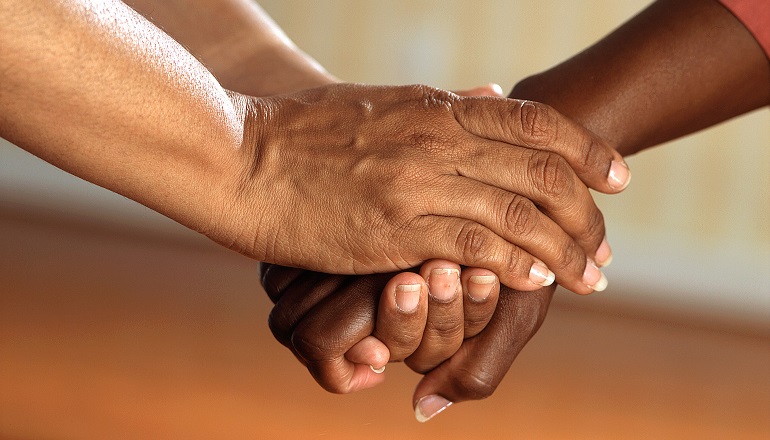“It’s not that I don’t love you, Mommy, and I don’t want to hurt your feelings,” sobbed my seven-year-old daughter. “But I need my black mother, too!” This unequivocal cry came as no surprise to me—or to my husband.
Our daughter has seemed aware of the loss of her birth mother since she joined our family at three months old. She has told us this with her behavior, her words, her choice of heroes, and most of all with the deep sadness in her that nothing seemed to alleviate. When she was just two, I remember her sobbing inconsolably, “My Mommy’s lost.” And I knew she didn’t mean me.
The Depths of Despair
Before we adopted Chrissie, our third child of four, we read extensively about parenting an adopted child and, in particular, about parenting a child adopted transracially. (Chrissie is first-generation African American; we are white.)
Although this reading helped us to do the things that white parents of children of color can do to instill racial pride and include birth culture in our daily life, it did little to prepare us for the pain and loss our child experienced as a result of having been adopted. From the day Chrissie was placed with us, we were often unable to comfort her when she cried.
As she got older, any loss, no matter how small, seemed to tap into an endless reservoir of grief: A dead goldfish, all the strawberries being eaten, saying good-bye to someone, and watching Barney the Dinosaur act out the story of the mother duck and her five missing baby ducks—all could provoke heartbroken sobbing. And when Chrissie cried, it was with profound grief.
As a preschooler, she could not respond to overtures of friendship from other children. She hid in a tunnel on the playground every day for months. She enjoyed the company of female adults (especially her godmother and a favorite teacher), but she tested them often. She got better with time, but her loneliness was always apparent.
Although we attended a racially integrated church, enrolled her in a small, integrated Christian school (5 of 14 first graders were black or Hispanic), and reached beyond the borders of our town for family friends and role models for Chrissie and her younger sister, Jane (also adopted), Chrissie continued to make disparaging comments about her skin, hair, and body.
She said often over the years that she believed her birth mother “looked at me and changed her mind” because “I was the ugliest baby in the world.” Nothing we did could convince her that she was a valuable, lovable, unique, and special person. When Chrissie was four, we sought the help of a therapist to work with her on issues of “fit.”
Although Chrissie knew we loved her, she was troubled by our racial difference and could not accept the idea that we were a family and would always be one. She believed that the only safe place was home, that everywhere else she was the subject of curious staring. For her there were too many differences between herself and other children, too many questions about why she was being raised in this family. We answered her questions to the best of our abilities, but there was always the most important question that we could not answer: Why had it been impossible for her to stay with her birth mother?
Taking the Only Action We Could
We became convinced that our daughter needed to know who she was, whom she came from, and, above all, why she was “given away.” Her health depended upon our responses to her questions. So, we set out, with the help of an adoption therapist, to locate and contact her birth mother and to turn a traditional adoption into a fully open one. We got the predictable warnings from friends:
- “Aren’t you afraid her birth family will want her back?”
- “What if her birth mother wants nothing to do with you?”
- “What if she wants to go and live with her real mother.”
- “Won’t you confuse her?”
Others thought we were giving in to the demands of a child who was asking for her birth mother in the same way in which she might request a dangerous all-terrain vehicle. Did we know anything about the family we were searching for? We had only a few sketchy details. We went forward, however, believing that, for our daughter, knowledge about her personal history and birth family, even if painful, would be better than a void that all the love in the world could not fill.
With help from a birth mother group, we learned the whereabouts of Chrissie’s birth mother. With help from our very knowledgeable adoption professional, we crafted a letter to her. We did not involve Chrissie in the search but allowed her the option of including a drawing or photo in our first letter.
When Chrissie’s birth mother responded, we asked her to meet with us and our advisor. Over a three-month period, we met and worked together to prepare for the day when Chrissie would first meet her birth mother. We wanted to be certain to keep Chrissie’s needs foremost.
Creating New Memories
Eight months have passed since our first meeting with Chrissie’s birth mother. For Chrissie and her birth mother, the process of becoming acquainted has been one of letting go. Chrissie’s birth mother is letting go of the last heartbreaking images she had of her baby daughter, and Chrissie is letting go, slowly, of her conviction that she was ugly, worthless, and not wanted. Together they are building trust.
The courage and optimism they bring to this complex relationship is breathtaking. In the beginning there were so many questions. How would a birth mother with a lot of unresolved grief and a child of seven with a lot of anger and hurt even begin to get to know one another? How much time would they spend together? How would our own relationship with our daughter change? How would our teenage sons deal with the intense emotions floating around?
The story of their developing relationship, however, belongs to them. All that I can say now is that all of the adults involved like and respect one another and communicate very well. Sometimes, in our enthusiasm for the relationships we adults have forged, we need to remind ourselves that Chrissie’s needs should guide our actions. She is brave and articulate, but she has a lot of hurt; this is not easy for her.
My husband and I are certain of this, though: our daughter seems more solidly planted in her life than ever before. As she learns information about her past and integrates it, she expends less energy dealing with the unknown. The more she develops a relationship with her birth mother, the more her sense of belonging right here where she is increases.
She is more confident now and less easily hurt. She no longer makes disparaging remarks about herself. Since meeting Chrissie’s birth mother, I have begun to write to Jane’s birth mother. We are sharing our lives as best we can, building a friendship. Jane knows we write and that she can participate in any way she likes. At this point she e-mails and sends drawings when she feels like it.
What I Wish I’d Known
As I look back on the last eight months, I know that we have been blessed with some of the most transforming days of our lives. This is what we have learned along the way:
- We should have been better prepared at the beginning of our adoption journey. If we had known more about the impact of traditional adoption on the lives of adopted persons, we would have been better prepared to make a decision in favor of openness from the beginning.
- At the outset, we could not hear about the pain and difficulties a child experiences with adoption. We wanted to believe love could make it all better.
- Being adopted IS different from growing up with the parents you were born to. Adoption always includes abandonment, in that this is the experience of the child who is separated from his or her mother.
- Secrecy devalues the birth family, and in so doing devalues the child. Even when contact is not appropriate, it is still possible to lift the curtain on the child’s early life.
- The disruption of the relationship between a mother and her baby, even at birth, constitutes a loss for both that is overwhelming. Our daughter grieved for years. We knew it, but we could not fill the void.
- A child as young as five can understand that she has two sets of mothers and fathers, but only one set of everyday parents, and that set is forever.
- When adoptive parents and birth parents keep the best interests of the child before them, wonderful things can happen.
- The support and wisdom of adoption professionals is invaluable in reunions. Many adoptive parents hesitate to return to their agencies when their children need help, hesitate to admit problems or that their child is not happy.
And yet, this is what adoptive parents must do. We must understand that our children have a past that did not include us, and that our children have a right to their own histories. We must acknowledge their losses and grieve with them.
A few days after her first meeting with her birth mother, Chrissie sent her an e-mail. Among other things, it said, “I wish I weren’t adopted, but I am strong. I really am happy that I found you. Did you want to keep me?” This is an amazing demonstration of strength and courage to face her life’s situation from a child so young. What joy for us that she is able to ask such a question of the one person who has the answer. When we let them, our children tell us what they need. We just have to have the courage to listen.
To protect the privacy of her daughters and her daughters’ birth mothers, the author has chosen to publish this article under a pseudonym. Chrissie’s and Jane’s names have also been changed. The author notes that her daughters are proud of their birth families but are not yet ready to claim publicly all the feelings and issues related to their searches. She can be reached at [email protected]. The adoption therapist who helped with this reunion was Dr. Joyce Maguire Pavao, [email protected].

